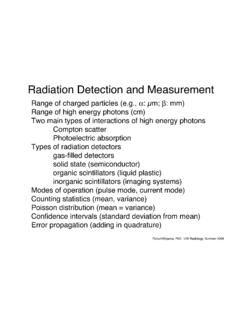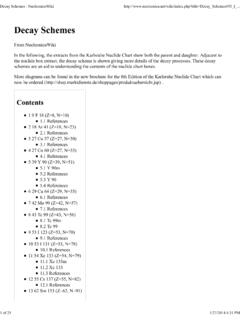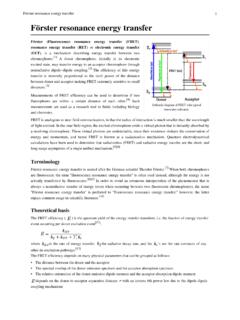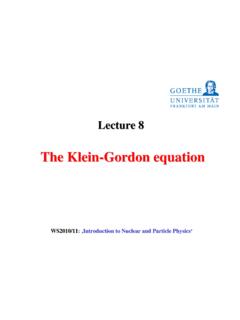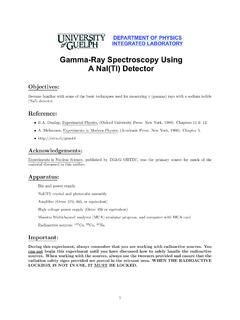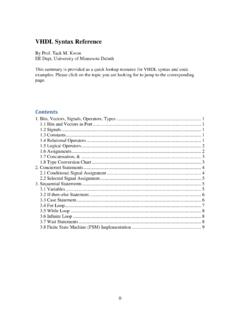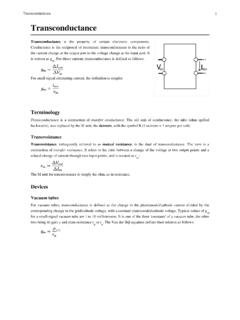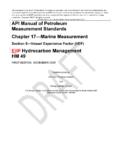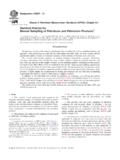Transcription of Chapter 9 CALIBRATION OF PHOTON AND ELECTRON BEAMS
1 301 Chapter 9 CALIBRATION OF PHOTON AND ELECTRON BEAMSP. A N D R E ODepartment of Medical Radiation Physics,University of Stockholm, Karolinska Institute,Stockholm, SEUNTJENS, PODGORSAKD epartment of Medical Physics,McGill University Health Centre,Montreal, Quebec, INTRODUCTIONM odern radiotherapy relies on accurate dose delivery to the prescribed target volume. The ICRU has recommended an overall accuracy in tumour dose delivery of 5%, based on an analysis of dose response data and on an evaluation of errors in dose delivery in a clinical setting.
2 Considering all uncer-tainties involved in the dose delivery to the patient, the 5% accuracy recom-mendation is by no means easy to clinical use, the output of PHOTON and ELECTRON BEAMS produced by external beam radiotherapy machines must be calibrated. This basic output CALIBRATION is but one, albeit very important, of the links constituting the chain representing an accurate dose delivery to the patient. The other links refer to: the procedures for measurement of relative dose data, equipment commis-sioning and quality assurance; treatment planning; and the actual patient set-up on the treatment machine.
3 The basic output for a radiotherapy machine is usually stated as the dose rate for a point P at a reference depth zref (often the depth of dose maximum zmax) in a water phantom for a nominal source to surface distance (SSD) or source to axis distance (SAD) and a reference field size (often 10 10 cm2) on the phantom surface or the isocentre. The output for kilovoltage X ray generators and teletherapy units is usually given in Gy/min, while for clinical accelerators it is given in Gy/MU. For superficial and orthovoltage BEAMS and occasionally for BEAMS produced by teletherapy radioisotope machines, the basic beam output Chapter 9302may also be stated as the air kerma rate in air (Gy/min) at a given distance from the source and for a given nominal collimator or applicator setting.
4 The basic output CALIBRATION of PHOTON and ELECTRON BEAMS is carried out with radiation dosimeters and special radiation dosimetry techniques. Radiation dosimetry refers to a determination by measurement and/or calculation of the absorbed dose or some other physically relevant quantity, such as air kerma, fluence or equivalent dose, at a given point of interest in a given radiation dosimeter is defined as any device that is capable of providing a reading M that is a measure of the dose D deposited in the dosimeter s sensitive volume V by ionizing radiation.
5 A dosimeter that produces a signal from which the dose in its sensitive volume can be determined without requiring CALIBRATION in a known field of radiation is referred to as an absolute dosimeter; Dosimeters requiring CALIBRATION in a known radiation field are called relative dosimeters. The basic output CALIBRATION of a clinical radiation beam, by virtue of a direct measurement of dose or dose rate in water under specific reference conditions, is referred to as reference dosimetry. Three types of reference dosimetry technique are currently known: (a)Calorimetry; (b)Fricke dosimetry; (c)Ionization chamber dosimeters can be used as absolute dosimeters but are seldom used as such in clinics, because their use in absolute dosimetry is cumbersome and, moreover, CALIBRATION in a known radiation field offers certain advantages, such as traceabilty to a standards laboratory.
6 When an absolute dosimeter is used independently, it relies on its own accuracy instead of referring to a standard in common with other radiation is the most fundamental of the three reference dosimetry techniques, since it relies on basic definitions of either electrical energy or temperature. In principle, calorimetric dosimetry is simple; in practice, CALIBRATION OF PHOTON AND ELECTRON BEAMS303however, the need for measuring extremely small temperature differences makes the technique very complex and relegates it to sophisticated standards main types of absorbed dose calorimeter are currently used in standards laboratories: Graphite calorimeters; Sealed water calorimeters.
7 In graphite calorimeters the average temperature rise is measured in a body that is thermally insulated from surrounding bodies ( jackets ) by evacuated vacuum gaps. Gap corrections and dose transfer procedures are used in conjunction with graphite calorimeters to allow for the transfer of absorbed dose from graphite to water. In stagnant sealed water calorimeters use is made of the low thermal diffusivity of water, which enables the temperature rise to be measured directly at a point in (continuous) water. Dose transfer procedures are not needed, but the measurement and analysis are complicated by the presence of conductive heat loss (or gain) and by the heat defect induced by dosimetryThe energy of ionizing radiation absorbed in certain media produces a chemical change in the absorbing medium, and the amount of this chemical change may be used as a measure of absorbed dose.
8 The best known chemical radiation dosimeter is the Fricke dosimeter, which relies on oxidation of ferrous ions into ferric ions in an irradiated ferrous sulphate solution. The amount of ferric ion produced in the solution is measured by absorption spectrometry with ultraviolet light at 304 nm, which is strongly absorbed by the ferric dosimetry (sometimes referred to as chemical dosimetry or ferrous sulphate dosimetry) depends on an accurate knowledge of the radiation chemical yield of ferric ions, measured in moles produced per 1 J of energy absorbed in the solution.
9 The chemical yield is related to an older parameter, the G value, defined as the number of ferric molecules produced in the ferrous sulphate solution by 100 eV of absorbed energy. An accurate value of the chemical yield is difficult to ascertain because the chemical yield is affected to a certain degree by the energy of the radiation, dose rate and temperature of the solution during irradiation and readout. The best G value for 60Co g rays is molecules per 100 eV, corresponding to a chemical yield of 10 6 mol/J. The typical dynamic range for ferrous sulphate Fricke dosimeters is from a few Chapter 9304grays to about 400 Gy, making Fricke dosimetry impractical for routine use in a chamber dosimetryThe ionization chamber is the most practical and most widely used type of dosimeter for accurate measurement of machine output in radiotherapy.
10 It may be used as an absolute or a relative dosimeter. Its sensitive volume is usually filled with ambient air and the dose related or dose rate related measured quantities are the ionization charge Q or ionization current I, respectively, produced by radiation in the chamber sensitive air mass mair. Charge Q and air mass mair are related to absorbed dose in air Dair by:( )where (Wair/e) is the mean energy required to produce an ion pair in air per unit charge (the current value for dry air is eV/ion pair or J/C).The subsequent conversion of the air cavity dose Dair to dose to medium (usually water) Dw is based on the Bragg Gray or Spencer Attix cavity theories (see Chapter 2 and Section in this Chapter ).
